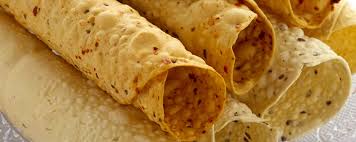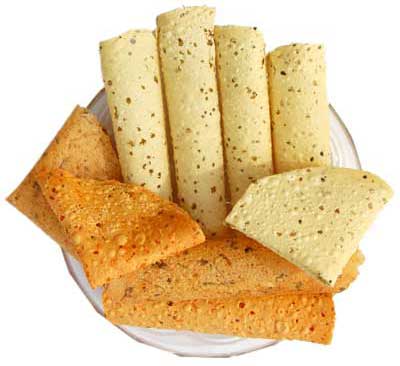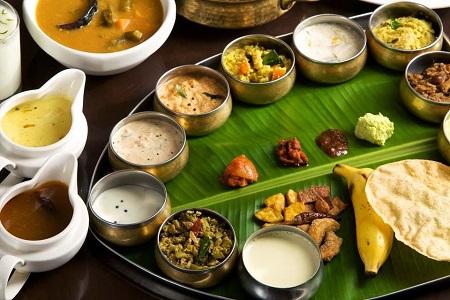
Singhania Public School
Home /
Home /
LIJJAT PAPAD- THE CRUNCH IN EVERY INDIAN PLATTER
 A papad is a thin, crisp, disc-shaped food from the Indian subcontinent; typically based on a seasoned dough usually made from peeled black gram flour (urad flour), either fried or cooked with dry heat (on an open flame). It is considered to be a quintessential part of the Indian meal with wide-spread popularity and flavors to please every taste-bud whether pungent pepper or plain garlic. The crisp treat remains to be one of most loved accompaniments and can modify a boring meal or can be served as a snack. Statistically speaking- the papad is Pan-Indian in its appeal. Each region had its own speciality – from south Indian rice papads ( called Appalams and also manufactured by Lijjat in its south Indian units) to those made with gram flour (besan) a staple in Rajasthan or the Punjabi papads full of pepper. Roasted papad with toppings or dips is often served as a cocktail snack. (Tacos can be called the humble papad’s international cousin) But what’s more interesting to note is that somewhere along the way papads went from being an accompaniment to becoming a modified street-food (Chaat) or even the popular version in spicy gravy.
A papad is a thin, crisp, disc-shaped food from the Indian subcontinent; typically based on a seasoned dough usually made from peeled black gram flour (urad flour), either fried or cooked with dry heat (on an open flame). It is considered to be a quintessential part of the Indian meal with wide-spread popularity and flavors to please every taste-bud whether pungent pepper or plain garlic. The crisp treat remains to be one of most loved accompaniments and can modify a boring meal or can be served as a snack. Statistically speaking- the papad is Pan-Indian in its appeal. Each region had its own speciality – from south Indian rice papads ( called Appalams and also manufactured by Lijjat in its south Indian units) to those made with gram flour (besan) a staple in Rajasthan or the Punjabi papads full of pepper. Roasted papad with toppings or dips is often served as a cocktail snack. (Tacos can be called the humble papad’s international cousin) But what’s more interesting to note is that somewhere along the way papads went from being an accompaniment to becoming a modified street-food (Chaat) or even the popular version in spicy gravy.  Papad, papar, papadam, poppadom - is made from varying ingredients, such as lentil flours – like black gram flour – chick peas, rice, and even tapioca, potatoes and other vegetables. It is also consumed alongside meals. It is known by various names all over the country including “Papad” in North, “appalam” in Tamil Nadu, “happala” in Karnataka, “appadam” in Andhra Pradesh and as “poppadum” in the United Kingdom. The word “pappadam” in Malayalam, Tamil and Sanskrit is the root word of Papad. In Sanskrit it stands for a thin type of cake prepared with rice or pea-flour and baked or cooked.. Papad is made using urad dal flour or the black gram flour, salt, oil and pepper. The urad dal is ground to form a fine powder to which salt, a little oil and crushed pepper are mixed. Thereafter water is added to form tight dough. The dough is divided and shaped into small balls which are rolled out and spread over mats and dried in shade or sun- baked for a little while, as they dry quickly. When made on a commercial scale they are collected after drying and packed to be sold. The final crisp Papad is the outcome of deep frying in hot oil. Some Papads can also be made by roasting on a flat pan or the Indian tawa.
Papad, papar, papadam, poppadom - is made from varying ingredients, such as lentil flours – like black gram flour – chick peas, rice, and even tapioca, potatoes and other vegetables. It is also consumed alongside meals. It is known by various names all over the country including “Papad” in North, “appalam” in Tamil Nadu, “happala” in Karnataka, “appadam” in Andhra Pradesh and as “poppadum” in the United Kingdom. The word “pappadam” in Malayalam, Tamil and Sanskrit is the root word of Papad. In Sanskrit it stands for a thin type of cake prepared with rice or pea-flour and baked or cooked.. Papad is made using urad dal flour or the black gram flour, salt, oil and pepper. The urad dal is ground to form a fine powder to which salt, a little oil and crushed pepper are mixed. Thereafter water is added to form tight dough. The dough is divided and shaped into small balls which are rolled out and spread over mats and dried in shade or sun- baked for a little while, as they dry quickly. When made on a commercial scale they are collected after drying and packed to be sold. The final crisp Papad is the outcome of deep frying in hot oil. Some Papads can also be made by roasting on a flat pan or the Indian tawa.  They can alternately be made by roasting in a microwave oven. In Kerala crisp Papads hand crushed while eating and had with jackfruit payasam or porridge. A chat or street snack called “papri chaat” makes use of deep fried or roasted Papad that is crushed and mixed with other ingredients including chopped onions, tomatoes, cucumber, seasonings and tangy spice mixes. The papad has been part of Indian culinary fare for what seems like forever. However, the papad business – developed mostly over the past couple of decades and has a fascinating history, with an interesting link to women’s empowerment in the country.
They can alternately be made by roasting in a microwave oven. In Kerala crisp Papads hand crushed while eating and had with jackfruit payasam or porridge. A chat or street snack called “papri chaat” makes use of deep fried or roasted Papad that is crushed and mixed with other ingredients including chopped onions, tomatoes, cucumber, seasonings and tangy spice mixes. The papad has been part of Indian culinary fare for what seems like forever. However, the papad business – developed mostly over the past couple of decades and has a fascinating history, with an interesting link to women’s empowerment in the country.
Papad making industry in India is one among the most successful cottage industries that supports many indigent households across the country. Mostly the womenfolk from rural and underdeveloped areas are encouraged to indulge in the occupation.


Singhania Public School
C/O
J K Paper Ltd CPM Colony,
Fort Songadh Dist-Tapi
(Gujarat)
Pin : 394660
spsfortsongadh@gmail.com
www.spsfortsongadh.com
+91-9328924004
Copyright 2024 Singhania Public School. All Rights Reserved. Powered by : Edunext Technologies Pvt. Ltd.
Copyright 2024 Singhania Public School
All Rights Reserved. Powered by Edunext
Visitor Counter : 1000